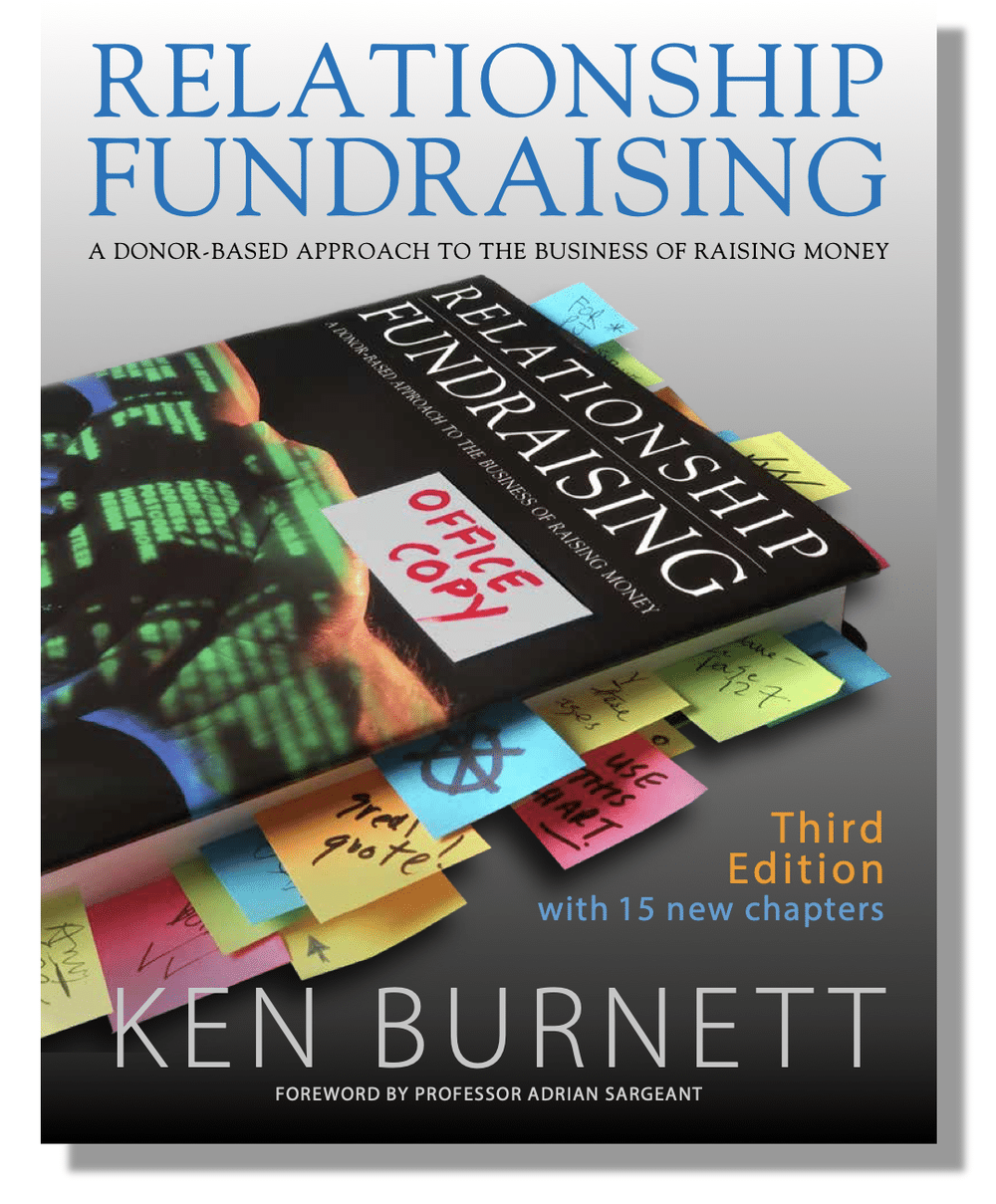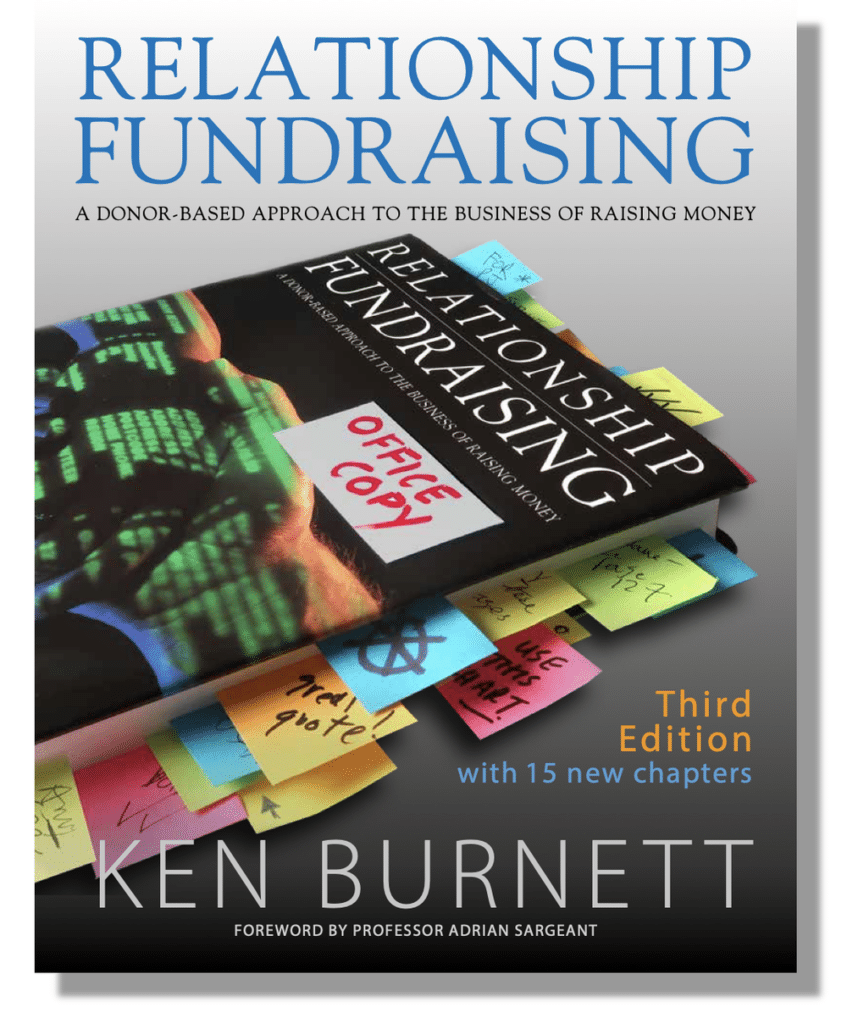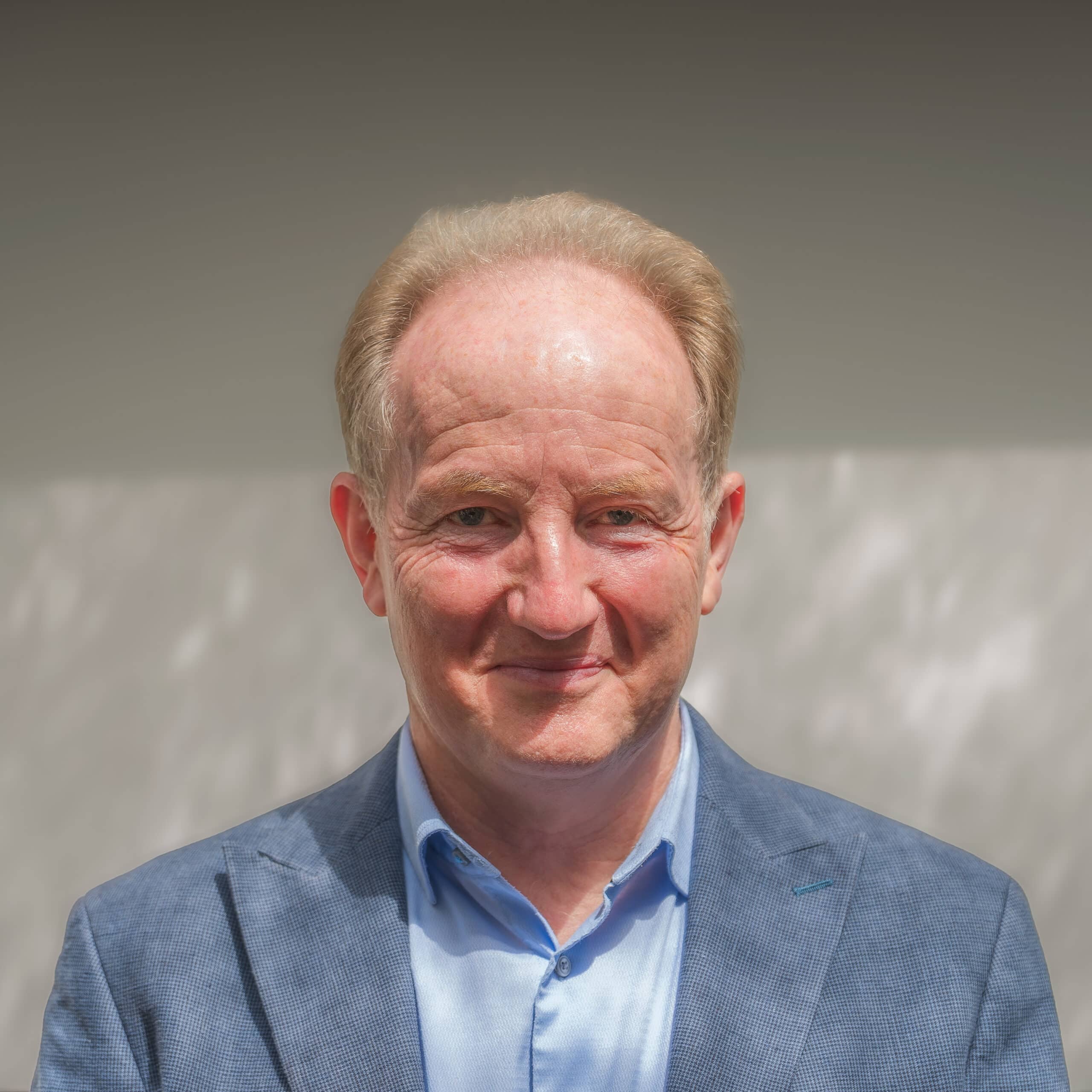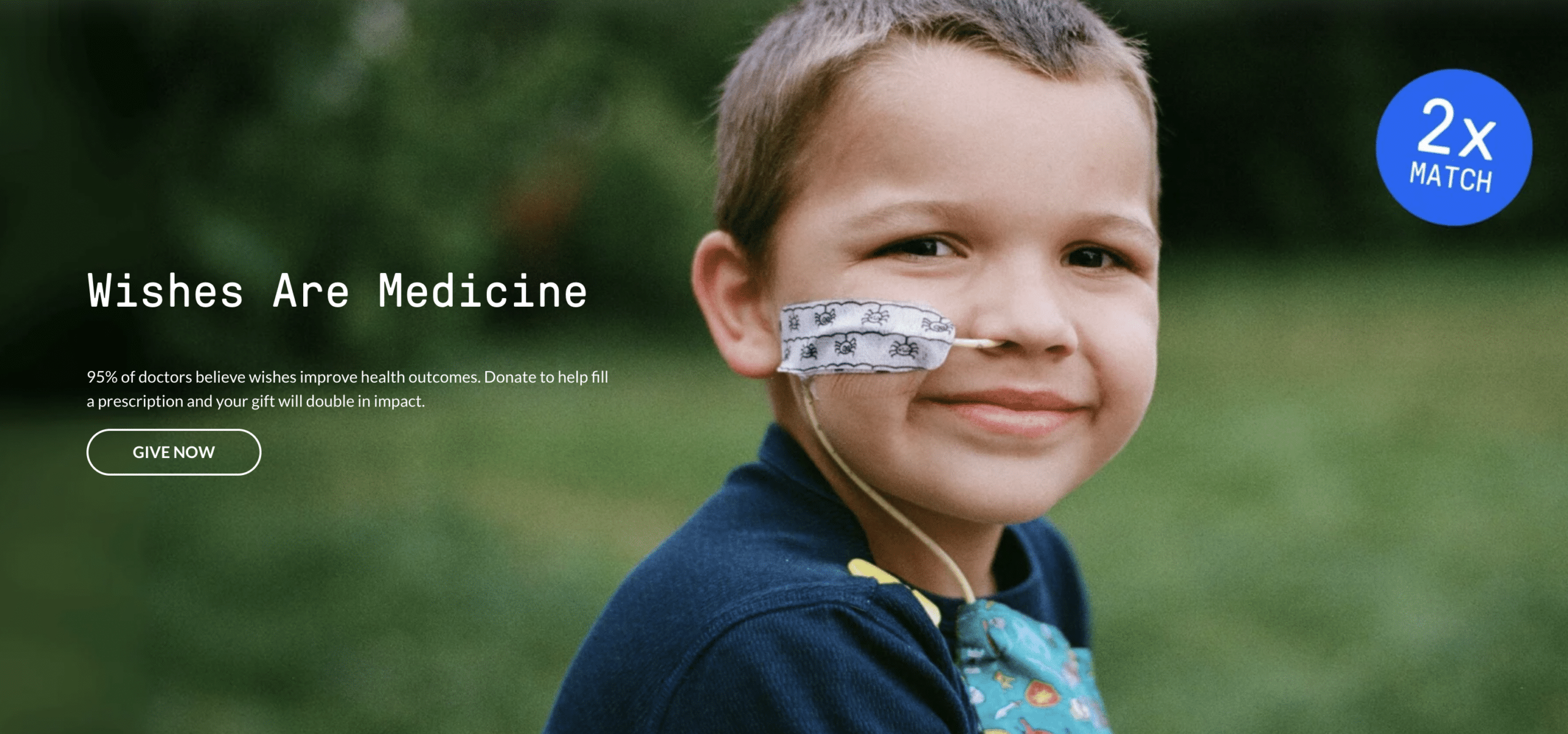Ken Burnett’s ‘Relationship Fundraising’: the 3rd and FINAL edition

In 1992, the first edition of Relationship Fundraising was published, one of the most acclaimed and best-selling fundraising books of all time. The book is a timeless classic for our field and mandatory reading for anyone who calls themselves a fundraiser.
This month, 32 years later, the 3rd and final edition has been published. I am very grateful that the author and fundraising legend Ken Burnett wanted to answer my questions. In this unique interview Ken explains where Relationship Fundraising comes from and why it is still so popular.

RS: What inspired you to write Relationship Fundraising, and how do you feel the fundraising landscape has evolved since its publication in 1992?
KB: “I started fundraising in my home country UK in 1977, long before fundraising was considered a proper, respectable career for anyone with any potential. Nevertheless I enjoyed considerable success in building the development organisation ActionAid from a tiny charity to be one of the UK’s top 20 by fundraised income. At the end of the 1980s there was no good book available for fundraisers in the UK, nor any good guidance at all. I had recently started my agency, Burnett Associates Ltd, the first direct marketing agency in the UK (and Europe, I believe) to specialise in working with charities.
So, I set out to write a detailed and competent ‘How to’ book that would help and inspire would-be fundraisers. Midway through the process of writing it I discovered relationship marketing, and for me, a light went on. So I changed tack, and moved from just the immediately practical towards something philosophical, with what my business partner George Smith called A Great Big Point of View. This was to suggest that fundraising should change. Fundraising shares some similarities with commercial enterprise, but mostly it’s distinctively different, particularly in its relationship with customers. Fundraisers, I believed, should understand the differences, and revel in them.
The fundraising landscape has changed significantly since 1992, particularly as communication (which is absolutely central to fundraising) has advanced so much – the Internet, mobile phones, social media, AI — all have arrived since the first copies of Relationship Fundraising appeared. But for fundraisers, far more things — most of the really important things — have stayed the same. In very many ways, the key components of our craft as set out initially in Relationship Fundraising are even more important now. And after the findings of The Commission on the Donor Experience (CDE) in 2017, the right way forward has never been clearer. Those findings were built upon the Great Big Point of View described in my 1992 book.”
RS: In what ways do you believe Relationship Fundraising has influenced the practices and strategies of nonprofit organizations over the years?
KB: “Initially I had very limited ambitions for the book, but consistently since its first publication I’ve been getting enthusiastic feedback from fundraisers around the world. Sales far exceeded my initial expectations — the book has had to be reprinted multiple times (of course this did my fledgling marketing and communications agency no end of good 🙂 ). It quickly became clear that readers were picking up the point that George highlighted in his brilliant foreword, that the book revolved around a Great Big Point of View. From the many positive comments I’ve received over the years, this from Professor Adrian Sargeant is one of my favourites. He described it as, “THE most influential, well written and beautifully warm text in fundraising.”
As far as I know, Relationship Fundraising was the first book to attempt to define the donor experience and work to deliver it at optimum. It encouraged all fundraisers to focus specifically on a lifelong mutually beneficial commitment: monthly giving leading to a legacy. It defined both of those as products and also encouraged creative storytelling and much improved communication. And it devoted a lot of space to presenting positively a career in fundraising. Robert Kawalko, chairman of the Polish Fundraising Association, said, “Ken talks about fundraising in such a way that everyone would like to become a fundraiser!””
RS: The third edition of Relationship Fundraising is set to be published soon. What inspired you to revisit and update the book at this particular time? Are there any key insights or new perspectives you’re excited to incorporate?
KB: “After 20 successful years the book’s second publisher, Wileys in the USA, came to the end of their copyright period. As there was still evident demand, a Canadian publisher Civil Sector Press International then stepped up to avoid the book going out of print.
Yes, there are many important new perspectives, mostly in the 15 new appendices I’ve added to the 3rd Edition to bring it up-to-date and relevant to all. The appendices detail how fundraising can go badly wrong, how relationship fundraising works brilliantly in practice (the Botton Village story, see below), the primacy of delivering an exemplary donor experience, transformational storytelling, legacy fundraising, target-setting, how giving is good for donors and fundraisers, the power of words, investment in fundraising, the vital importance of a distinctive organisational culture, giving every fundraiser the best possible start, retaining and developing fundraisers, creating a new covenant with donors and the dream of a new era of responsible fundraising, with some nods along the way to false economies, the advent of AI, the essence of good fundraising and understanding what really matters.”

“YES, THERE ARE MANY IMPORTANT NEW PERSPECTIVES, MOSTLY IN THE 15 NEW APPENDICES I’VE ADDED TO THE 3RD EDITION TO BRING IT UP-TO-DATE AND RELEVANT TO ALL.”
RS: Given the rise of digital platforms and social media, how do you see relationship fundraising adapting to these new channels of communication and engagement? What advice would you offer to organizations navigating this digital landscape?
KB: “I’m no digital expert. Whatever the channel through which fundraisers communicate with donors, both current and potential, all the tenets of relationship fundraising unquestionably apply. I’ll just say two things here: 1) communicate carefully, tell your stories powerfully and truthfully using clear writing and correct grammar and punctuation, because you won’t inspire many donors if you are careless with words, and 2) learn to write succinctly as well as powerfully, because your readers’ attention spans are now generally assumed to be getting shorter. As always the key thing is to be interesting, relevant and passionate — then your readers will stick with you, come what may.”
RS: Building and maintaining relationships with donors is at the core of relationship fundraising. Can you share some practical strategies or tactics that organizations can employ to cultivate meaningful connections with their supporters?
KB: “Believe in your donors and let them drive your strategies. Put the donor experience at the heart of all your communications. Fundraisers should be famous for frequent, fast, fabulous feedback (the 5Fs). Integrity and honesty are essential: ‘the truth, told well’, is a mantra I use a lot. Use real named people, make them accessible at times that suit your donors. Let your principles and your passion show through, clearly.”
RS: In recent years, data-driven fundraising has been increasingly embraced by the charity sector. In your opinion, how can data-driven fundraising strengthen relationship fundraising?
KB: “In the 1st Edition I said, “The fundamental core of relationship fundraising is the creative use of your database. It is the keystone.” Without the ability to use supporter data smartly, safely and securely, most fundraising initiatives will fail. Like me, most fundraisers won’t be data experts, but we do need to know what we want to get from our database and to have a clear grasp of what today’s databases are capable of. I strongly recommend Steve MacLaughlin’s book Data-driven Nonprofits, for it shows how fundraisers seriously underinvest in their data and spells out the consequences of this short-sighted approach.”
RS: What are the most common misconceptions or myths surrounding relationship fundraising? How would you debunk or address them?
KB: “It’s now abundantly clear that successful fundraising is based on long-term relationships and that a donor-based approach to the business of raising money works very much better than any alternative. So I think most of the myths are being overcome. It’s now accepted that relationship fundraising is not a soft option, it’s not difficult, nor is it expensive, time-consuming or unprofitable. There are many case histories around that show it leads to happier and more successful fundraisers and to donors who stay longer and give more, not the reverse. There are however many organisational barriers, such as short-term thinking, lack of investment particularly in research, unwise target-setting, poorly briefed suppliers, ill-informed and unengaged boards and SMTs, poor training and leadership. The best advice for anyone still in doubt is to read my book, and to buy extra copies for their board and SMT, as well as for all fundraising and ancillary staff.”
RS: The concept of donor-centricity is central to relationship fundraising. How can organizations ensure that their fundraising efforts remain genuinely donor-centric, especially in the face of competing priorities and fundraising goals?
KB: “Donors’ interests are the same as the organisation’s. If donors are happy, inspired and get easy access to all the benefits of being a donor, then they’ll keep the fundraisers happy, for sure. I don’t believe any fundraising organisation should have priorities and goals that run contrary to those of the people who pay for everything our organisations do.”
RS: Can you share a standout recent example of successful fundraising that exemplifies the principles outlined in Relationship Fundraising? What made it so effective?
KB: “Two case histories spring to mind, one from the start of my career, the other just recently. I learned much about relationship fundraising from Botton Village (now fundraising as part of the Camphill Village Trust). Botton Village’s story is told in detail on SOFII.org. Starting in 2017 I’ve been privileged to help the UK’s National Youth Orchestra build from scratch a robust donorbase of regular donors that through donations and legacies will provide for all their fundraising needs into the future. We began fundraising with Botton Village in the early 1980s. Recently the fundraiser who started the programme with me estimated that over the years their legacy income alone from these activities has been between £100 million and £180 million. In both cases, what made them so successful is putting the donor experience at the heart of their strategies and culture, and doing fundraising right.”
THE BOTTON VILLAGE’S STORY AS CASE STUDY ARTICLE AND AS LIGHT BULB MOMENT VIDEO.
RS: Looking ahead, what do you envision as the future of relationship fundraising? Are there any emerging trends or innovations that you believe will shape the next evolution of fundraising practices?
KB: “This is a sliding doors situation. It could be one of two or possibly three things:
1. We could see transformational culture change across the charity sector leading to dramatically and consistently improved donor experiences with widespread understanding of enhanced benefits from giving for donors, which leads to reduced attrition and substantially increased income for good campaigning fundraising organisations…
2. …or we could see a major decline in trust and confidence among donors, following a repetition of the Olive Cooke fiasco, leading to a widespread decline in fundraised income, legacies cancelled, high donor attrition and expensively escalating staff turnover as fundraisers manage decline…
3. …or, it could just be more of the same, individual examples of charities doing a good job overshadowed in the public mind if not eclipsed by the majority who employ short-term, cash-now tactics that do nothing to improve the low opinion our publics have of the fundraising practices they’d love to be able to avoid more easily…”
Thank you so much for this interview Ken.
Needless to say, I recommend every fundraiser to buy and read this book.
Republished with permission from Reinier Spruit at Reinier Fundraising.


